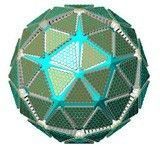
-
StatusCompleted
-
Status date2010-06-22
-
Activity Code7-.001
The scope of the project was to identify and deeply investigate an innovative Tx/Rx antenna solution able to provide entertainment services in Ku-band in an aeronautical mobile environment. The main requirement was to avoid any mechanical movement in the beam scanning and in the polarization alignment so a completely electronic scanning was required. Dual polarization was required, both circular and linear. Moreover, to minimize the impact of the antenna on the aircraft, a single Tx/Rx antenna has been preferred. The identified solution was a conformal hemispherical array, depicted in the reported figure.
It has been proved that it is always possible to identify the correct phase and amplitude setting of the active modules which allow to achieve at least 25dB of XPD.
The electrical performances of the antenna, calculated considering the measurements performed on the antenna demonstrator, are 43dBW of EIRP and 8dB/K of G/T in the most part of the operative band and in almost the entire hemisphere.
The thermo-mechanical analyses showed that the antenna concept is a feasible solution presenting good stiffness and strength and no particular criticalities from the thermo-mechanical point of view.
The radiating element and the active modules are the key enabling technologies that allowed to develop the described antenna architecture. Their characteristics make them suitable for many different antenna architectures, representing the real competitive core of the project. The exploitation of these components can be considered the basis for future antenna architecture able to answer to challenging requirements such as dual polarization control, low profile, electronic beam steering and so on.
In the frame of the project the antenna that has been studied is characterized by a hemispherical envelope able to homogeneously cover the hemispherical field of view. To simplify the manufacturing and to make easier the maintenance of the antenna, a panelized solution has been studied and the final configuration is composed by 40 identical triangular tiles of 36 radiating elements. Each radiating element is a dual-polarized Tx/Rx self-diplexing patch, electronically controlled by two active modules, one for Tx (called mPAU, Polarization Adjustment Unit) and one for Rx (called mPRU, Polarization Recovery Unit). These active modules are responsible for the polarization alignment and for the beam steering, allowing to avoid any mechanical movement of the antenna.
All the electronic components needed for the correct functioning of the antenna is accommodated into the hemispherical envelop. The antenna block diagram is reported hereafter.
The active modules needed to be digitally controlled so, near the RF BFN, a digital BFN is required. Moreover, a Logic Unit provides the correct phase and amplitude setting to the active modules and a power supply provides the needed voltages and currents. The thermo-mechanical behaviour of the antenna has been studied and accommodation aspects have been properly addressed.
After a detailed scenario study, a deep review of the regulatory aspects has been assessed also considering the accommodation of the antenna on the aircraft.
A first issue of antenna requirements has been identified for the trade-off among different antenna architectures considered. The preferred antenna architecture, i.e. the hemispherical antenna array, has been designed in deeper and deeper details during the project.
A demonstrator has been designed, manufactured and tested to prove the feasibility of the solution and the achievable performances. Considering the results of the measurement activity, a final review of the antenna performances has been carried out.
The project is at its finale stage, having already performed the Final Review Meeting.








